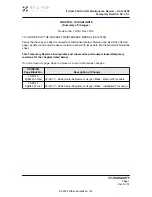
Pilot Operating Handbook
Cavalon
SECTION 7
SYSTEM DESCRIPTION
AutoGyro_POH_Cavalon 915iS
Revision 1.0 – Issue Date 08.MAY.2019
7-5
7.8
Rotor System
The two-bladed, semi-rigid, teetering rotor system comprises high-strength aluminium
extruded rotor blades, a hub bar, and a common teeter hinge assembly.
The rotor blades feature an aerodynamic profile especially suitable for rotorcraft which, in
combination with its relative centre of gravity, provides aerodynamic stability by eliminating
negative blade pitching moments and flutter tendency. The hollow blade profile is closed at
both ends by plastic blade caps.
The aluminium rotor hub bar is pre-coned to the natural coning angle of the blades and
connects the blades firmly to each side using 6 fitting bolts and a clamping profile. In order
to compensate for asymmetric air flow in forward flight the blades are free to teeter. The
hinge assembly consists of teeter tower, teeter bolt and teeter block.
The teeter bolt runs in a long Teflon coated bushing in the teeter block (main bearing
action), as well as two shorter bushings in the teeter tower (emergency bearing action). The
main bearing action is supported by special grease which is applied through a grease nipple
on top of the teeter block. Servicing is described in SECTION 8 of this manual.
7.9
Vibration Damping
A certain level of vibration is inherent to any 2-bladed rotor system. In order to reduce
vibration levels to a minimum, a vibration decoupling element in the rotor mast isolates rotor
vibration from the fuselage.
7.10 Flight Controls
Rotor head and trim control
Pitch and roll of the gyroplane are controlled by
tilting the complete rotor head by means of the
control stick. Control input is transferred via torsion
tube and linkage running below the seats to the
base link and from there to the rotor head via push-
pull control cables.
The control stick head is ergonomically shaped to
fit the pilot’s right hand and features control buttons
for radio transmission (1), a four-way trim function
(2), and activation of the pre-rotator (3).
The trim control works as a classical 4-way beep
switch. Pulling the beep switch back increases aft
trim or nose-up tendency, while pushing the switch
forward reduces back trim pressure, leading to a
nose-down tendency. Roll trim is affected by
pushing the trim switch to the respective side.
Because of a safety circuit, activation of the pre-rotator is only possible with the pneumatic
mode selector in FLIGHT position and the control stick fully forward. This prevents
inadvertent activation of the pre-rotator during flight or in BRAKE mode.
Control stick head
1 – Radio transmission
2 – Trim switch
3 – Pre-rotator















































